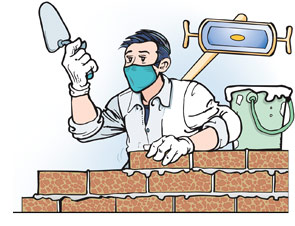Can Dentists Rebuild Bone?
New technology allows for predictable bone regeneration
Dear Doctor,
I recently went to my dentist to consider having an implant to replace a missing tooth. I was told that I didn't have enough bone to anchor an implant and bone would have to be grown first. I was amazed, how do you rebuild bone?

Dear Mary Ann,
Your dentist is right. It is very important today to maintain “bone volume” following removal of a tooth. This helps to ensure that future implants can be placed in the best possible position. Today, most dentists are in agreement that when considering an implant after the removal of a tooth, a bone graft should be placed into the extraction site to prevent the very problem you are now encountering. Sufficient bone volume for implant placement (the part that replaces the tooth root) is vitally important to proper crown placement (the part that attaches to the implant and that you see in the mouth), resulting in the most natural looking and properly functioning tooth.
Modern dentistry and oral surgery have come a long way. Understanding the principles of wound healing now allows for regeneration of bone to occur using a variety of techniques. Most include opening the gingival (gum) tissues to expose the bone and then augmenting the existing or remaining bone by adding bone grafting materials to it. Healing of the grafted material can be enhanced by the utilization of “guided bone regeneration” membranes which cover the grafts and act like little subterranean band-aids, along with other biologically active molecules (found normally in the body) which also promote and enhance healing.
Bone regeneration for implant dentistry is a usual and routine procedure in periodontal and oral surgery.
An important consideration in regenerating bone is how much bone is actually needed. For a “one tooth” implant site the amount of bone grafting material needed is relatively small so that it can be taken from a variety of sources. Your dentist or surgeon (periodontist or oral and maxillofacial surgeon) can select from a variety of bone grafting materials. He can select an area of your own jaw bone referred to as an autograft (auto-self, graft-tissue transplant). As a living source of bone cells, autografts have certain advantages that can help regenerate new bone and because it is already a part of your body it offers patients piece of mind. The disadvantages of autografts include creating a second surgical site and, though the stimulation for bone tissue regeneration is present, it is limited. There are also a variety of processed grafting materials including: an allograft using tissue from the same species, i.e. another person; a xenograft from another species, i.e. animals or from synthetic or man-made materials. All of these grafting materials have been processed so that they are safe for human use. Your dentist will recommend which grafting material he would like to use and which material he/she has used with success. Most bone grafting materials are utilized by your body as a “scaffold” for bone regeneration, allowing your body to replace the graft material with its own bone.
Sometimes an implant can be placed with a bone graft at the same time allowing new bone to be regenerated simultaneously, provided there is enough of your own natural bone to at least stabilize the implant when it is placed.
Most of these surgical bone regeneration procedures are carried out with local anesthesia (numbing shots) to the area, or with the aid of oral or intravenous (conscious) sedation, which put you in a conscious but twilight sleep or relaxed state. Usually antibiotics are needed to prevent infection together with minor anti-inflammatory and pain control medication.
Bone regeneration for implant dentistry is a usual and routine procedure in periodontal (supporting tooth structures) and oral surgery. The scope of the surgery to build new bone will depend upon many factors beyond the scope of this short consultation. Speak to your dentist, a periodontist or an oral and maxillofacial surgeon who can properly assess your individual situation and tell you exactly what is needed, together with all the appropriate risks, benefits and treatment alternatives.




